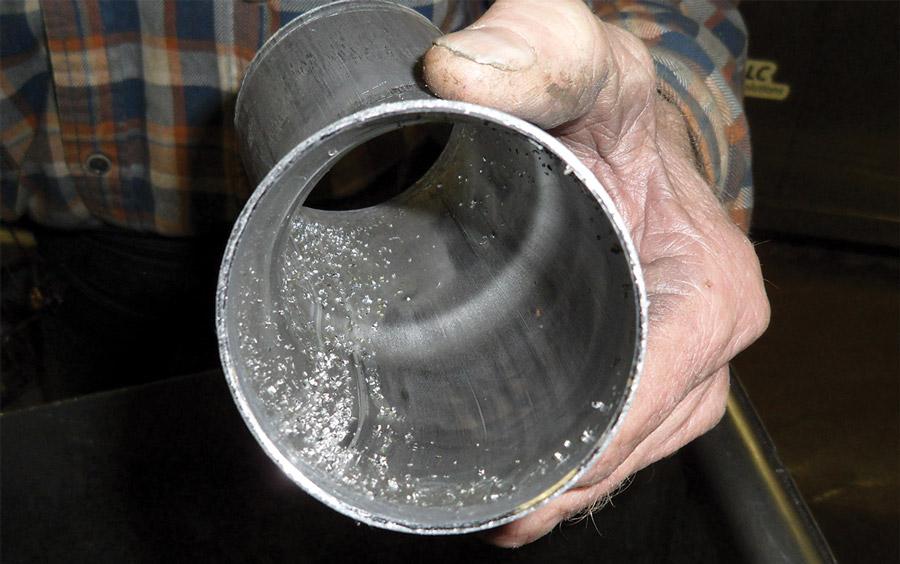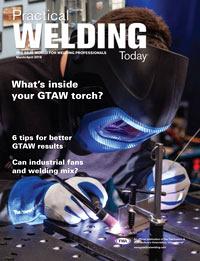- FMA
- The Fabricator
- FABTECH
- Canadian Metalworking
Categories
- Additive Manufacturing
- Aluminum Welding
- Arc Welding
- Assembly and Joining
- Automation and Robotics
- Bending and Forming
- Consumables
- Cutting and Weld Prep
- Electric Vehicles
- En Español
- Finishing
- Hydroforming
- Laser Cutting
- Laser Welding
- Machining
- Manufacturing Software
- Materials Handling
- Metals/Materials
- Oxyfuel Cutting
- Plasma Cutting
- Power Tools
- Punching and Other Holemaking
- Roll Forming
- Safety
- Sawing
- Shearing
- Shop Management
- Testing and Measuring
- Tube and Pipe Fabrication
- Tube and Pipe Production
- Waterjet Cutting
Industry Directory
Webcasts
Podcasts
FAB 40
Advertise
Subscribe
Account Login
Search
Heartthrob finds a less exhausting way to clean parts
Exhaust system manufacturer adopts ultrasonic cleaning process
- By Eric Lundin
- April 18, 2016
- Article
- Tube and Pipe Fabrication
Cleaning the inside of a long, multibend tube is no simple feat, and Mike Forbes, a co-owner of Heartthrob Exhaust Accessories, Litchfield, Minn., would know. The company manufactures new exhaust systems for racing teams, and it makes many other components, such as air intakes, coolant tubes, and heat exchanger tubes.
Heartthrob’s position in the market—if Heartthrob doesn’t have it and we can’t get it, we’ll make it for you—means that Forbes is no stranger to the many twists and turns of tube and pipe. He’s similarly knowledgeable about the oil, lubricants, and debris of the manufacturing process for shaped and often customized parts. Cleaning these parts before shipping them was accomplished by hand, a labor-intensive undertaking that produced inconsistent results. Now, with the addition of a new parts washer from UltraSonic LLC, Forbes found a less exhausting way to clean parts.
Cleaning the Uncleanable
Exhaust tubes, air intakes, and coolant tubing are just some of the products that come out of Heartthrob’s factory to be shipped across the country, but before they go anywhere, they have to be cleaned thoroughly. A biodegradable, vegetable-based lubricant used as part of the manufacturing process must be removed before the product is shipped to customers. During the bending and finishing processes, steel burrs and other debris collect on the tube, inside and out. Similarly, a thin film of a rust-inhibiting oil must be removed. While exhaust system customers are more forgiving of these materials, oil or debris on the intake, air, and coolant tubes may result in returns or rejects.
The largest of Heartthrob’s exhaust pipes are up to 10 feet long and contorted five times, making cleaning very difficult. Smaller tubes also have to be cleaned; because they are so numerous, cleaning them requires a lot of time. Until this year, Forbes’ employees cleaned the pipes and tubes by hand
in two 55-gallon drums. They dunked and scrubbed the parts individually in clean and soapy drums. Each small air intake or air coolant tube took several minutes to clean, wasting valuable production time.
It was not only labor-intensive, it was miserable work, especially if a part was too large for the drums. Hearththrob works with tubes from 1 to 6 inches in diameter and 2 in. to 10 ft. long. If that 6-in.-dia., 10-ft.-long tube needed to be washed in the middle of winter, an unlucky employee would have to take the pressure washer outside to hose down the product. In Litchfield the temperature rarely breaks 40 degrees F from November to March, and temperatures well below zero aren’t uncommon, making pressure washing outdoors a particularly wretched endeavor. Heartthrob had a hard time keeping employees.
“The mist would often freeze in the winter,” Forbes said. “Guys who got stuck doing [that] didn’t stick around too long,” he said.
A Less Exhausting Way
Heartthrob Exhaust doesn’t lose employees to the cold Minnesota weather anymore. All cleaning operations now have moved inside and are performed by one machine, an Ultra 6000FLT ultrasonic cleaner manufactured by UltraSonic LLC.
Ultrasonic cleaning is a precision parts cleaning technology that uses high-frequency sound waves to remove dirt and contaminants from parts (see Figure 1). Micro-sized bubbles are formed from the alternating pressure waves generated from the high-energy transducers. Energy is transferred to and stored within these bubbles. As the bubbles contact the parts to be cleaned, they implode, releasing the stored energy and creating a microjet, creating a scrubbing action which dislodges contaminants from the parts. Dirt, oils, and other dislodged contaminants then settle to the bottom of the tank.
The process of formation and implosion of these tiny bubbles, called cavitation, is common to all ultrasonic cleaners. What is unique about the UltraSonic LLC technology is the placement of the transducers on the side of the tank rather than the bottom, as is common practice.

Figure 1
Dirt, lubricant, and debris often remain inside
tube after bending, cutting, and other
manufacturing processes (top). Ultrasonic
cleaning is effective for cleaning such
parts, inside and out (bottom).
Side-mounting the transducers provides a consistent cleaning action from top to bottom, with no blind spots. A V-shaped bottom also allows the dirt to collect on the bottom without interfering in the transducer’s wave path and permits easy cleaning.
The machine combines both of these design features with a 210-gal. main tank, which has a basket capacity of 36 in. long by 24 in. wide by 7.5 in. high. The unit can clean rubber and plastic parts, bearings, bolts, transmission components and engine parts, and other parts of various materials and sizes.
If the Part Fits …
Employees can wash a large batch of small tubes together in one cycle. An optional dual-basket configuration is available, allowing several small baskets to be processed simultaneously. This is suitable for cleaning large batches of small components, a mix of large parts and a basket of small parts, or a few of the company’s largest parts in one cycle, which was its main reason for purchasing the machine. This is a big improvement over hand-washing dozens of small tubes and pipes or spending an hour scrubbing the ID of a five-bend exhaust tube by hand in the middle of January.
With a six-minute cycle time, the unit has drastically cut Heartthrob’s tube cleaning time. Often, Forbes’ employees can fit 20 or more tubes in a cycle. Employees now just have to load the machine and can work elsewhere until the cycle is finished.
“I’d say it takes us a third of the time as before to clean, or maybe a fifth,” Forbes said. “It depends on the tube.”
With a digital control system, employees can control the type of cleaning required for various cycles of different loads. Employees simply load the machine, press a programmed cycle, and pull the parts out. No scrubbing or exposure to freezing temperatures are required. Because it uses no dangerous chemicals or solvents, it’s a safer cleaning process.
“The cleaner saved us a lot of time, a lot of labor, and it helped us retain some employees who might not be too happy doing some very difficult work outside in the elements,” Forbes said.
Recently, Forbes tested the cleaner by placing a dab of lube in the middle of a five-bend exhaust tube. After a run through the machine, he cut the pipe in half. In the middle of the pipe, the most difficult spot to clean, it looked brand new. Forbes’ employees even bring auto parts from their home projects to clean on lunch break.
“One employee brought in some rusty heads, and it did a remarkable job on parts and conditions we would not normally use it for in our business,” Forbes said. As far as the parts and conditions they do normally use it for, it has essentially made rejects and complaints about cleanness a thing of the past.
Heartthrob Exhaust Inc., 320-693-0222, www.heartthrobexhaust.com
UltraSonic LLC, 513-502-9746, www.ultrasonicllc.com
About the Author

Eric Lundin
2135 Point Blvd
Elgin, IL 60123
815-227-8262
Eric Lundin worked on The Tube & Pipe Journal from 2000 to 2022.
About the Publication
subscribe now

The Welder, formerly known as Practical Welding Today, is a showcase of the real people who make the products we use and work with every day. This magazine has served the welding community in North America well for more than 20 years.
start your free subscription- Stay connected from anywhere

Easily access valuable industry resources now with full access to the digital edition of The Fabricator.

Easily access valuable industry resources now with full access to the digital edition of The Welder.

Easily access valuable industry resources now with full access to the digital edition of The Tube and Pipe Journal.
- Podcasting
- Podcast:
- The Fabricator Podcast
- Published:
- 04/16/2024
- Running Time:
- 63:29
In this episode of The Fabricator Podcast, Caleb Chamberlain, co-founder and CEO of OSH Cut, discusses his company’s...
- Trending Articles
Sheffield Forgemasters makes global leap in welding technology

ESAB unveils Texas facility renovation

Engine-driven welding machines include integrated air compressors

The impact of sine and square waves in aluminum AC welding, Part I

Compact weld camera monitors TIG, plasma processes

- Industry Events
16th Annual Safety Conference
- April 30 - May 1, 2024
- Elgin,
Pipe and Tube Conference
- May 21 - 22, 2024
- Omaha, NE
World-Class Roll Forming Workshop
- June 5 - 6, 2024
- Louisville, KY
Advanced Laser Application Workshop
- June 25 - 27, 2024
- Novi, MI



























